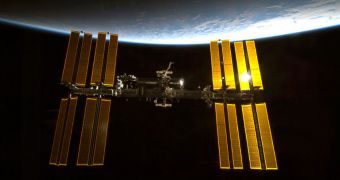Even if the American space agency decided to prolong the life of the International Space Station until at least 2020, NASA is still considering its actions for when the massive space facility will need to be deorbited. Details of its plans have now been made public.
One of the most important things experts need to consider when developing plans to remove the ISS from orbit is the station's amazing size – it is about as large as an American football field.
The $100 billion orbital facility also features a large number of components, and is configured in a very peculiar manner, in the sense that it does not resemble a block.
According to experts at NASA, the largest challenge facing deorbiting teams is brining the station down in one go, and making its debris fall in remote and rarely-circulated oceanic waters.
When the orbital facility goes down, it will be only the second large space station to be deorbited, after the 2001 event which saw the Russian-built MIR being directed to the waters of the Pacific Ocean.
The agency also has its environmental impact responsibilities to consider, given the nature of the ISS' mission and the hazardous compounds that can be found aboard.
But the destruction process will most likely have positive aspects as well, according to investigators. They say that some of the components could conceivably be harvested for other uses in space.
But tearing the 400-ton mammoth apart, and picking out the still-useful pieces will be a tremendous engineering challenge all on its own, Space reports.
The US needs to expand ISS operations “likely to 2020 or beyond, and expand efforts to: utilize the ISS for scientific, technological, commercial, diplomatic and educational purposes; support activities requiring the unique attributes of humans in space; serve as a continuous human presence in Earth orbit; and support future objectives in human space exploration,” says a US policy.
The National Space Policy for the United States (NSPUS) was released by President Barack Obama this June, and subsequently approved by Congress in a somewhat different form.
Details of how NASA will get rid of the station were presented this October in a paper called “ISS End-of-Life Disposal Plan,” which was showcased at a Aerospace Safety Advisory Panel Briefing.
The document was prepared by the NASA ISS program manager Michael Suffredini. It says that America will most likely cooperate with the European Space Agency (ESA) for this complex task.
Additional discussions are also being carried out with the Russian Federal Space Agency (RosCosmos). NASA wants to see whether Progress space capsules can be modified to assist with the deorbiting process, by providing critically-need thrust.
The new plan will also be used in case something goes wrong on the ISS before 2020, and astronauts need to be evicted. If out of control, the station can wreak havoc among satellite in low-Earth orbit.
“After another 10 or more years, the station partners will have a very good idea what parts have a lot more life and usefulness left, or lend themselves to living on as part of a new vehicle,” says Tom Jones.
“I think our station partners will do the smartest thing, which is to wring every last bit of utility out of the ISS in its present or future form,” he adds.
“When an end to the station's useful life appears on the horizon, I truly hope NASA will figure out with its partners what parts might be recycled or repurpose,” adds Jones, an ISS visitor and former shuttle astronaut.

 14 DAY TRIAL //
14 DAY TRIAL //